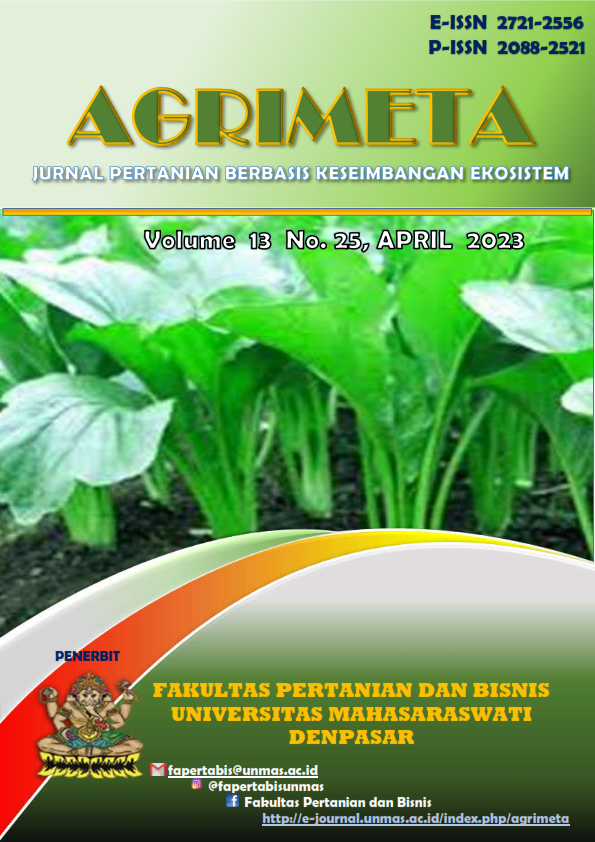EFISIENSI ALOKATIF FAKTOR PRODUKSI USAHATANI JAGUNG HIBRIDA PADA KELOMPOK MANYI MERTA TANI DESA TANGGUNTITI TABANAN
Keywords:
hybrid maize, factors of production, production allocativeAbstract
The objectives of this study are: 1) To analyze the production factors on the amount of hybrid corn production in Tangguntiti Village 2) To analyze the level of allocative efficiency of production factors in hybrid corn farming activities in Tangguntiti Village, the location of the study was done (deliberately), the sample in the study These 35 people were determined by the simple random sampling method with the help of the Slovin formula. This study used the Coob Douglas production function analysis method. The results of this study only variable land area, hybrid corn seeds, urea fertilizer, NPK fertilizer, pesticides, organic fertilizers, and labor together have an effect of 0.689% while 31.1% is influenced by variables outside the model with the hybrid corn production function Y = 1.046,28(X10,061)(X20,054)(X30,14)(X40,116)(X50,197)(X6-0,70)(X70,014). Production factors that have a signify-cant effect on corn production are organic fertilizers with a production elasticity of 0.197, and those that do not significantly affect hybrid corn production are land area, hybrid corn seeds, Urea fertilizer, NPK fertilizer, Pesticides, and labor with production elasticity of 0.061, 0.054, 0.140, 0.116, 0.70 and 0.014. While the inefficient: Land area, Organic Fertilizer, Pesticides, and Labor, while the inefficient production factors: Hybrid corn seeds, Urea fertilizer, and NPK fertilizer.
Downloads
References
Anwarudin, M.J., Sayekti, A.L., Marendra, A., & Hilman, Y. 2015,” Dinamika Produksi dan Volatilitas Harga Jagung : Antisipasi Strategi dan Kebijakan Pengembangan”. Jurnal Pengembangan Inovasi Pertanian. 8 no 1:33-42
Badan Pusat statistik. 2016 Produksi Jagung Menurut Kabupaten/Kota Denpasar Tahun 2016-2020.BPS., https://bali.bps.go.id
Betea, K., dan Werenfridus, T. 2016.”Faktor-Faktor yang Mempengaruhi Produksi Usahatani Jagung di Desa Tapenpah Kecamatan Insana Kabupaten Timor Tengah Utara”. 3, no 1:7-9.
Emir, NM. Aini, N. Koersniharti. 2015. Pengaruh Aplikasi Pupuk Organik dan Anorganik Terhadap Pertumbuhan dan Hasil Tanaman jagung ( Zea Mays L.)
Naibaho, D. K. 2018.”Analisis Jagung di Desa Suka, Kecamatan Tiga Panah, Kabupaten Karo.” E-Jurnal Agribisnis Universitas Sumatera Utara no 10: 20-70.
Purwidiantoro, dkk. 2016. peran sector pertanian sebagai penunjang Pertumbuhan pereko-nomian Indonesia.
Silaban E.T.,E purba dan J. Giting. Pertumbuhan dan Produksi Jagung(zea mays ) Pada berbagai jarak Tanaman Dalam jurnal online Agroekoteknologi no 1: 806-818.
Usahatani Lisa, Widiati, dan Muhanniah, 2018. ”Jurnal Produksi Tanaman”. November no 11, pp. 1845-1850.
Yusuf M, & Ramadhani, Y. 2011. “Analisis efisiensi skala dan elastisitas produksi dengan pendekatan cobb-douglas dan regresi berganda”. Jurnal Teknologi no 4: 61-68






